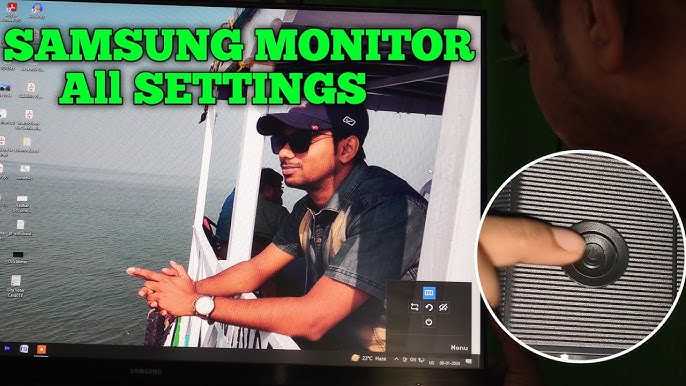To quickly adjust the contrast on your IPS monitor, access the monitor’s menu, find the contrast setting, and tweak it to your preferred level. Using the monitor’s physical buttons or on-screen display (OSD), you can easily fine-tune contrast for sharper images and better viewing comfort. Remember to save your settings before exiting.
Adjusting contrast on an IPS monitor is straightforward and can dramatically improve your viewing experience. Whether you’re gaming, working, or watching movies, the right contrast setting makes images pop and reduces strain on your eyes. Many users overlook this simple adjustment, unaware that their display can be optimized for clarity and color depth. This guide will walk you through easy steps to find and set the perfect contrast on your IPS monitor, ensuring vibrant visuals tailored to your preferences. With just a few clicks, you’ll enjoy a more vibrant and comfortable display every time you turn on your screen.
How to Adjust Contrast on IPS Monitor
Adjusting the contrast on your IPS monitor can greatly improve your viewing experience. Proper contrast settings help preserve image details and ensure colors look vibrant and accurate. In this guide, you’ll learn step-by-step how to change the contrast effectively and what factors to consider for optimal display quality.
Understanding Contrast and Its Importance
Contrast refers to the difference between the brightest whites and the darkest blacks on your screen. Higher contrast makes objects stand out more, while lower contrast offers a softer look. Proper contrast settings can prevent eye strain and make images appear more natural.
For IPS monitors, contrast is especially important because they are known for their color accuracy and wide viewing angles. Adjusting contrast correctly helps you enjoy detailed visuals whether you’re gaming, working, or watching videos.
Common Methods to Adjust Contrast on IPS Monitors
There are generally two main ways to change contrast settings: through the monitor’s physical buttons or via software on your computer. Each method has its advantages and is suitable for different situations.
Using Monitor On-Screen Display (OSD) Buttons
This is the most direct method. Locate the physical buttons on your monitor, usually at the bottom or side frame. Press the menu button to access the on-screen display menu.
Navigate to the contrast setting, often labeled as “Contrast” or “Picture,” using arrow keys or a joystick. Adjust the contrast level by increasing or decreasing the value until you reach the desired visual quality.
Adjusting Contrast Through Computer Settings
Some operating systems and graphics cards provide options to modify contrast via software. On Windows, you can go to Display Settings or use graphics control panels like NVIDIA Control Panel or AMD Radeon Settings.
Select the monitor or display, then look for color or display adjustments. Some graphics cards allow you to change contrast directly, giving you finer control over your display’s appearance.
How to Find the Best Contrast Level
Finding the optimal contrast involves balancing brightness and color accuracy. A good starting point is setting the contrast to the middle or default level and then making incremental adjustments.
Use test images or color calibration tools to check your adjustments. Look for clear distinction between light and dark areas without losing details or causing eye strain.
Steps to Properly Adjust Contrast on Your IPS Monitor
- Set your monitor to its default or factory reset setting to start with a neutral baseline.
- Adjust brightness first, as contrast and brightness work together for optimal picture quality.
- Access the contrast menu via physical buttons or software control panel.
- Increase or decrease the contrast in small steps, observing the image as you go.
- Use test patterns or calibration images to evaluate the contrast adjustments.
- Fine-tune until you see a clear difference between bright and dark areas without losing details.
- Save your settings and review the display in different lighting conditions to ensure consistency.
Tips for Maintaining the Best Contrast Settings
- Keep your monitor’s firmware and drivers updated for accurate control options.
- Adjust contrast periodically, especially if lighting conditions in your environment change.
- Avoid setting contrast to maximum, as it can cause washed-out images or loss of detail.
- Use calibration tools when possible to get precise settings tailored to your needs.
- Maintain a consistent viewing environment to prevent the need for frequent adjustments.
Additional Factors to Consider When Adjusting Contrast
Ambient Lighting
Room light influences how you perceive contrast. Bright rooms may require higher contrast settings, while darker rooms benefit from softer adjustments. Always calibrate in the same lighting conditions you typically use your monitor.
Type of Content
Different tasks may need different contrast levels. Editing photos might require lower contrast for subtle color grading, whereas gaming or watching movies benefits from higher contrast for dramatic visuals.
Color Profile Settings
Adjusting contrast works best when your monitor is running on a standard color profile. Use sRGB or Adobe RGB profiles for consistent and accurate color reproduction, which complements contrast adjustments.
Common Issues and How to Fix Them
Too Dark or Too Bright Screen
If your screen appears too dark or overly bright after adjusting contrast, revisit your brightness settings first. Sometimes, contrast adjustments need to be balanced with brightness to prevent visual fatigue.
Color Banding or Loss of Detail
Excessively high contrast can create color banding or make details disappear in shadows or highlights. Reduce contrast slightly to restore clarity and depth.
No Change After Adjustment
If adjustments seem ineffective, check your monitor driver and software settings. Reset to default and try again, ensuring your monitor supports contrast changes properly.
Summary of Key Points
| Method | Advantages |
|---|---|
| Physical Buttons (OSD menu) | Quick, hardware-based control, no software required |
| Software Settings | Finer control, accessible through operating system or graphics card software |
Adjusting contrast on an IPS monitor is a simple yet impactful process that improves overall display quality. By understanding your monitor’s controls and considering environmental factors, you can set contrast levels that bring out the best in your visual content. Remember to revisit your settings regularly, especially when lighting or usage changes, to maintain a comfortable and vibrant viewing experience.
Make your monitor look like OLED display. #pc #pctips #techtok #pcsetup
Frequently Asked Questions
What steps should I follow to adjust the contrast settings on my IPS monitor directly through the display menu?
To adjust contrast via your monitor’s menu, press the menu button on your monitor to open the display settings. Navigate to the ‘Picture’ or ‘Display’ section, then locate the ‘Contrast’ option. Use the navigation buttons or dial to increase or decrease the contrast level until the image appears clear and balanced. Save your settings before exiting the menu.
Can I modify contrast settings using my computer’s graphics card control panel instead of the monitor menu?
Yes, you can change contrast settings through your graphics card control panel, such as NVIDIA Control Panel or AMD Radeon Settings. Open the control panel, find the display or color adjustment options, and look for contrast controls. Adjust the slider to your preferred level, then apply the changes. Keep in mind, some settings may override monitor-level adjustments.
What adjustments should I make for optimal contrast to reduce eye strain during long working hours?
Set the contrast to a level that provides clear differentiation between light and dark areas without causing eye fatigue. Typically, a medium to high contrast is suitable, but avoid extremes. Adjust the brightness and contrast together to achieve a comfortable viewing experience, and consider enabling any eye protection features your monitor offers.
Are there recommended contrast settings for different types of tasks, like photo editing or gaming?
For photo editing, aim for precise contrast settings that preserve image details, usually in the middle range. For gaming, higher contrast can enhance visual depth and make elements pop. Adjust contrast based on your activity, ensuring the display remains comfortable and provides the necessary visual clarity for the task at hand.
What should I do if adjusting the contrast via the monitor menu doesn’t improve my display quality?
If changing contrast settings doesn’t help, check for other display issues like color calibration, brightness levels, or firmware updates. Reset the monitor to factory settings, then try adjusting again. If problems persist, consider testing the monitor on a different device or contacting customer support for further assistance.
Final Thoughts
Adjusting contrast on your IPS monitor enhances image clarity and visual comfort. First, access your monitor’s on-screen display menu using the buttons usually located on the side or bottom of the monitor. Navigate to the contrast setting, then increase or decrease it until the display appears vibrant yet balanced.
Remember, the right contrast setting depends on your environment and preference. To efficiently adjust contrast on IPS monitor, focus on subtle changes to avoid losing detail. Proper calibration ensures sharp images and comfortable viewing for extended periods.

I follow the latest trends in smart devices, portable monitors, and gaming accessories. My goal is to provide real-world insights that help readers make smarter tech decisions.




